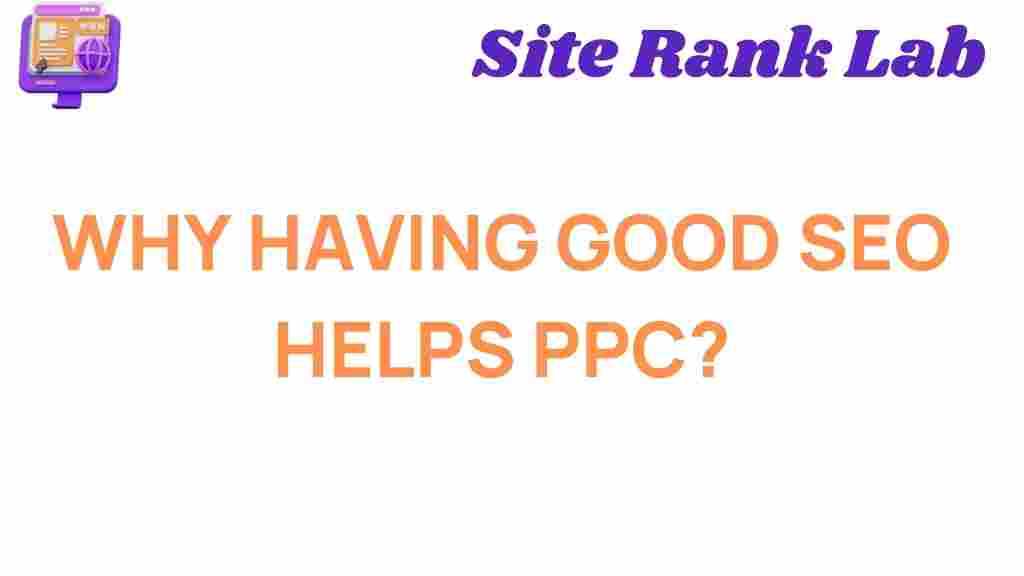Unveiling the Connection: How Good SEO Elevates PPC Success
In the ever-evolving landscape of digital marketing, the synergy between SEO (Search Engine Optimization) and PPC (Pay-Per-Click advertising) is becoming increasingly vital for businesses aiming to enhance their online visibility. Both strategies serve the common goal of driving traffic to websites, but they operate on different principles and have unique advantages. Understanding how effective SEO can elevate your PPC success can lead to improved conversion rates and a more robust online presence. In this article, we will delve into the intricate relationship between SEO and PPC, offering insights on keyword strategy, advertising effectiveness, and traffic generation.
The Basics of SEO and PPC
Before exploring their connection, let’s define the two concepts:
- SEO: This is the process of optimizing a website to rank higher in organic search engine results. It involves on-page elements like content quality and keyword usage, as well as off-page factors such as backlinks.
- PPC: This is an online advertising model where advertisers pay a fee each time their ad is clicked. It primarily focuses on gaining immediate visibility on search engines and social media platforms.
The Interplay Between SEO and PPC
While SEO and PPC are distinct strategies, they can complement each other in several ways:
- Keyword Strategy: The keywords that perform well in your PPC campaigns can inform your SEO efforts. By analyzing which keywords yield the highest conversion rates, you can optimize your website content accordingly.
- Data Sharing: Both strategies can share valuable data. Insights gained from PPC campaigns regarding user behavior, click-through rates, and conversion metrics can significantly enhance your SEO strategy.
- Brand Visibility: Running PPC ads alongside your organic search results increases overall visibility. Having your brand appear in both sections helps establish credibility and trust with potential customers.
- Remarketing Opportunities: PPC allows for remarketing to users who have previously interacted with your site. By improving the site’s SEO, you can attract more organic traffic to enhance your remarketing lists.
Step-by-Step Process to Leverage SEO for PPC Success
Here’s a structured approach to harness the power of SEO to boost your PPC campaigns:
1. Conduct Comprehensive Keyword Research
The first step is to identify the right keywords for both SEO and PPC. Utilize tools like Google Keyword Planner or SEMrush to find keywords relevant to your industry.
- Focus on long-tail keywords that show intent.
- Analyze competition and search volume.
- Identify keywords that convert well in PPC campaigns.
2. Optimize Landing Pages
Your landing pages play a crucial role in both SEO and PPC. Optimize them to ensure they are relevant to the keywords you are targeting.
- Ensure fast loading times to reduce bounce rates.
- Incorporate compelling calls-to-action (CTAs).
- Use high-quality images and concise, engaging content.
3. Create High-Quality Content
Regularly publishing high-quality content can enhance your SEO efforts and improve your PPC results. Consider the following tips:
- Utilize the keywords identified in your research.
- Focus on providing value to your audience.
- Keep content updated and relevant to current trends.
4. Monitor and Analyze Performance
Use analytics tools to monitor the performance of your SEO and PPC efforts. Key metrics include:
- Click-Through Rate (CTR): Indicates how well your ads are performing.
- Conversion Rate: Measures how effectively your landing pages convert visitors.
- Quality Score: A metric used by Google Ads that reflects the relevance of your ads, keywords, and landing pages.
5. Test and Iterate
Digital marketing is dynamic, so continuous testing is essential:
- Experiment with different ad copies and landing page designs.
- Adjust your keyword strategy based on performance data.
- Utilize A/B testing to determine the most effective tactics.
Troubleshooting Common Issues
Even with the best strategies in place, you may encounter challenges. Here are some common issues and troubleshooting tips:
Problem: Low Click-Through Rates (CTR)
If your CTR is below average, consider the following:
- Review your ad copy for relevance and appeal.
- Ensure your keywords are aligned with user intent.
- Test different ad formats and extensions.
Problem: High Bounce Rates
A high bounce rate on landing pages can indicate a mismatch between your ads and landing content:
- Ensure that the landing page content aligns with the ad messaging.
- Optimize for mobile users, as many users will click through from mobile devices.
- Improve page load speed.
Problem: Low Conversion Rates
To address low conversion rates:
- Evaluate the user journey from ad click to conversion.
- Implement clear and persuasive calls-to-action.
- Consider offering incentives or limited-time promotions.
Conclusion
The connection between SEO and PPC is undeniable. By leveraging insights from both strategies, businesses can enhance their online visibility and drive more targeted traffic to their websites. A well-rounded approach that incorporates effective keyword strategy, high-quality content, and data-driven decision-making will not only improve your advertising efforts but also lead to higher conversion rates.
As the digital landscape continues to evolve, staying ahead requires a harmonious integration of SEO and PPC tactics. By understanding and implementing the strategies outlined in this article, you can create a powerful digital marketing ecosystem that maximizes your online presence.
For further reading on enhancing your digital marketing strategies, check out this comprehensive guide. And for more insights on SEO and PPC trends, visit this resource.
This article is in the category SEO and created by SiteRankLab Team
